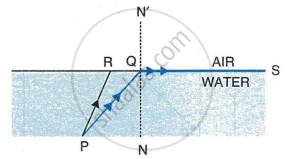Advertisements
Advertisements
Question
A light ray does not bend at the boundary in passing from one medium to the other medium if the angle of incident is ______.
Options
0°
45°
60°
90°
Solution
A light ray does not bend at the boundary in passing from one medium to the other medium if the angle of incident is 0°.
APPEARS IN
RELATED QUESTIONS
Name the factors affecting the critical angle for the pair of media.
Angle of deviation is the angle which the ______ ray makes with the direction of ______ray.
What do you understand by the deviation produced by a prism? Why is it caused?
In the given figure PQ and PR are the two light rays emerging from an object P. The ray PQ is refracted as QS.

- State the special name given to the angle of incidence ∠PQN of the ray PQ.
- What is the angle of refraction for the refracted ray QS?
- Name the phenomenon that occurs if the angle of incidence ∠PQN is increased.
- The ray PR suffers partial reflection and refraction on the water-air surface. Give reason.
- Draw in the diagram the refracted ray for the incident ray PR and hence show the position of image of the object P by the letter P’ when seen vertically from above.
A ray of light incident at an angle of incidence ‘i’ passes through an equilateral glass prism such that the refracted ray inside the prism is parallel to its base and emerges from the prism at an angle of emergence ‘e’.
What can you say about the value of the angle of deviation in such a situation?
Which of the following is not involved in formation of a rainbow?
Answer the following question.
Under what conditions are total internal reflection possible? Explain it with a suitable example.
Answer the following question.
What are the advantages of optical fibre communication over electronic communication?
Define the critical angle.
An endoscope uses optic fiber to transmit high resolution images of internal organs without loss of information. The principle of light that is used by the optic fiber is based on ______.
